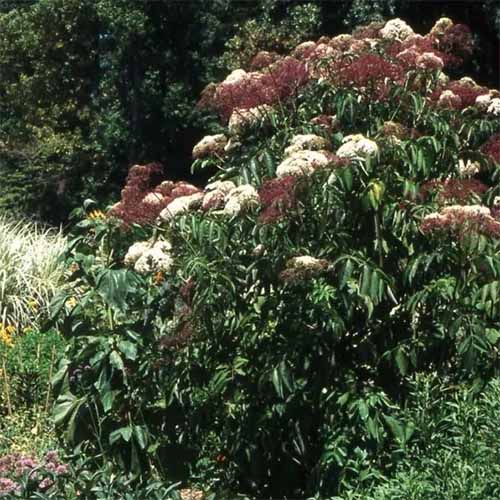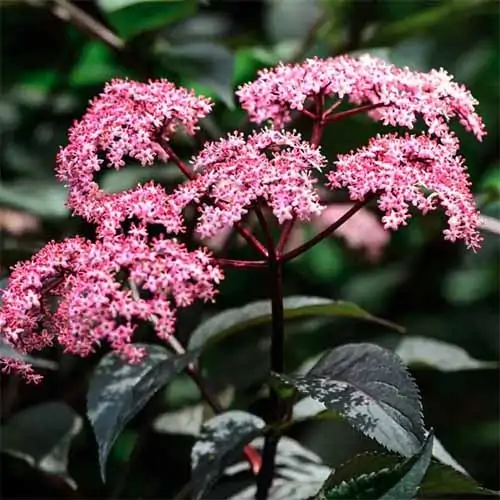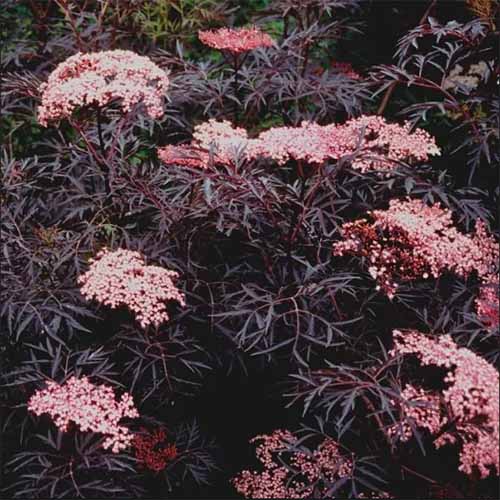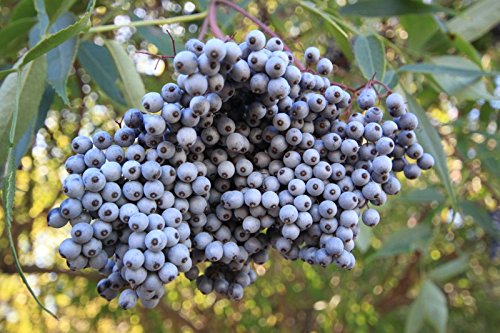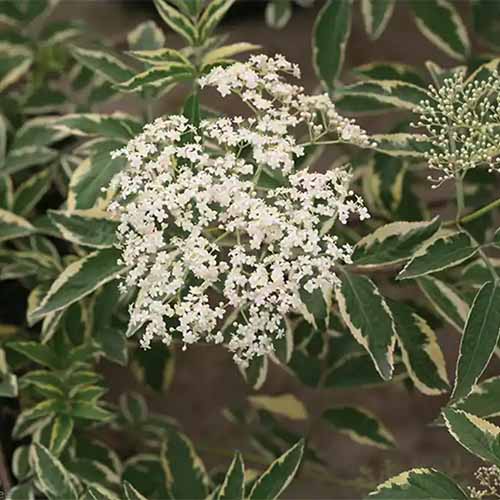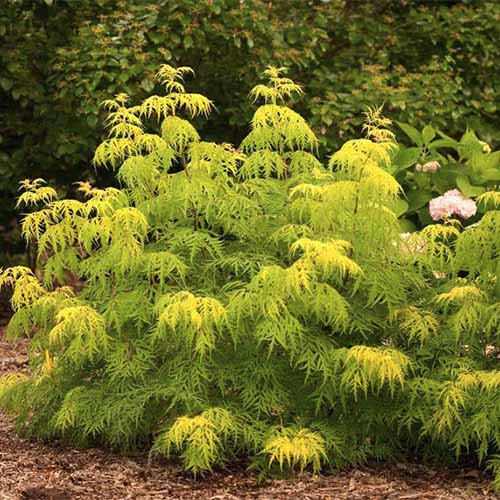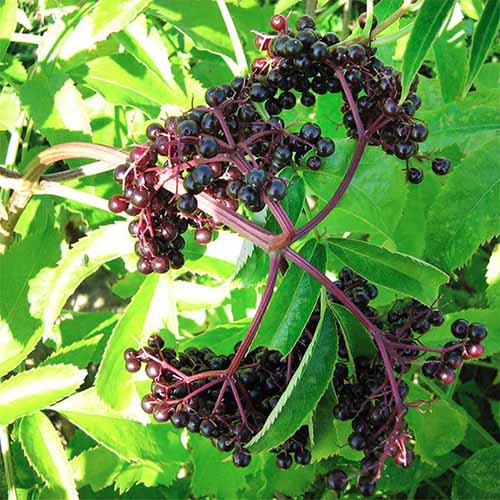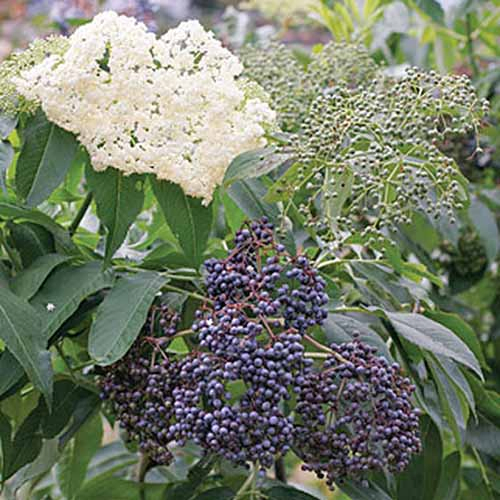TOP ELDERBERRY VARIETIES TO EASILIY GROW IN YOUR GARDEN
Though they are not widely known, elderberries are one of the most versatile and productive plants in the garden world.
Native to many parts of the United States, they have offered shade, protection, beautiful flowers, and tasty berries to their keepers and the local wildlife for generations. In short, they require very little care and give back so much!
Whether you choose to grow them as a hedge, a place for butterflies to visit, or for food and medicinal recipes, you won’t be disappointed by the benefits they offer.
And this plant is hearty enough for even first-time growers to master.
If you live in a growing zone that is pleasing to this shrub, I highly recommend giving elderberries a chance.
1. Adams
‘Adams’ is a cultivar of native Sambucus canadensis. It is one of the most common elderberries grown in North America and is similar to those found growing wild.
The signature white flowers, and large clusters of dark purple fruits, make it easily identifiable as a beautiful yard accent.
At full height, this beautiful bush can reach between six and 10 feet tall. It will thrive in USDA Hardiness Zones 3 to 9.
Find live plants for sale in #3 containers from Nature Hills Nursery.
Alternatively, you can purchase ‘Adams’ and ‘Johns’ planted together in a two-gallon container from Fast Growing Trees.
2. Black Beauty
An import from Europe, Black Beauty® aka S. nigra ‘Gerda,’ has very dark leaves, pinkish blooms, and a unique lemon scent.
It is best suited for growing in Zones 4 to 7 and prefers moist or even wet growing conditions.
A smaller elderberry variety, this plant will grow to no more than six feet tall at maturity, but responds well to pruning.
Like other elderberries, it produces luscious fruits that have become popular for making delicious wines. Buy two to ensure proper pollination.
You can find this plant for sale as a potted shrub from Nature Hills Nursery.
3. Black Lace
Black Lace® aka S. nigra ‘Eva’ has dark leaves that appear lacy throughout the growing season. When the flowers bloom, you’ll be delighted to find that they are pink!
This plant also produces the same versatile berries as other more common varietals.
Many gardeners find that the plant’s need for moisture makes it a perfect rain garden addition.
A bit smaller than other bushes, these plants will grow to just eight feet tall at full height. It’s easy to prune, so feel free to trim it to the height that works best with your landscape design plans.
Black Lace® thrives in Zones 4 to 7. It is available in #1 and #2 containers from Nature Hills Nursery.
4. Blue
This plant is native to the western United States, Mexico, and the West Coast.
With large, powdery-blue berries, it can sometimes be confused for a form of blueberry. The fruits on this stunning bush are known for having a rich flavor.
This variety differs from others in that it grows best from seed.
It thrives in warmer regions, and therefore is best suited for Zones 3 through 10. At maturity, it can reach a height of 10 to 30 feet, with a spread of 18 feet under ideal growing conditions.
Seeds for this unique plant are available from Amazon.
5. Instant Karma
S. nigra Instant Karma® features variegated green and white foliage and dark purple fruits, making it a beautiful yard accent.
Owners of the plant are usually stunned by how birds and pollinators are attracted to the large, showy white flowers. Butterflies are almost always nearby!
Plant this variety with Black Lace® or Black Beauty® for pollination.
You can expect this variety to reach a mature height of six to eight feet.
Find plants in quart-size containers available from Home Depot.
6. Lemony Lace
Lemony Lace®, S. racemosa ‘SMNSRD4,’ is a very hardy and showy plant that has feathery, light-colored leaves, and produces red fruits in the fall, after the white flower bunches have died away.
Amazingly deer-, cold-, and wind-resistant, it does well in full sun and is a prized plant in the northern United States. It’s versatile enough, however, to thrive in partial shade in southern states as well.
A smaller cultivar, this type typically attains a height and spread of three to five feet at maturity.
Plant in Zones 3 to 7 and enjoy this adaptable plant with its uniquely beautiful chartreuse color.
Please note that some experts caution against eating the berries from S. racemosa cultivars, specifically those with red berries.
Lemony Lace® is available from Nature Hills Nursery in #3 containers.
7. York
Another S. canadensis cultivar, ‘York’ is reported to have the largest berries and the highest fruit yield.
This resilient breed is also cold tolerant, making it a perfect choice for Zones 3 to 9. Many growers use it as a natural fencing solution, since bushes can grow up to 12 feet tall.
Fall brings about a beautiful color change in this plant. Foliage becomes bright red before dropping off for the winter.
‘York’ is available as one- to two-feet bare roots or shrubs in #3 containers from Nature Hills Nursery.
Elderberry Collection, 2 Bare Root Plants
Though most varieties of elderberry are self-fruiting, you can encourage higher yields by planting another cultivar of the same species nearby.
‘York’ and ‘Adams’ make excellent companions, and you can purchase bare root plants paired conveniently in the Elderberry Collection that is available from Burpee.
Which Plant is Best?
With so many options to choose from, it may be difficult to decide on a favorite. Luckily, most elderberries grow well together, giving you the choice to try multiple types for a rainbow of florals.
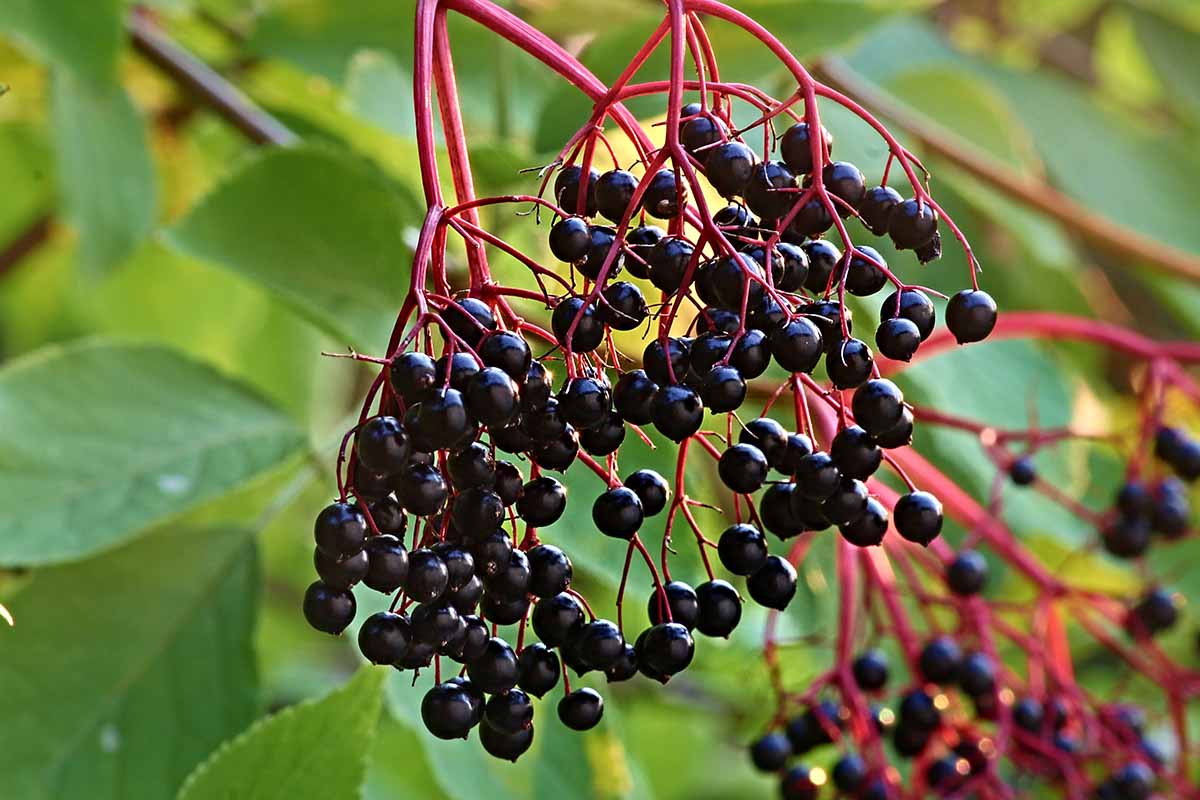
If it is your first time growing, you will likely do well with an established bush in a pot.
Remember that every breed thrives in moisture and works well in butterfly ecosystems. You can’t go wrong with the benefits that these varieties provide!

